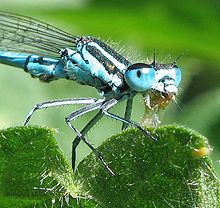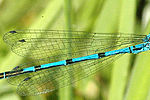- Azure Damselfly
-
Azure Damselfly 
Scientific classification Kingdom: Animalia Phylum: Arthropoda Class: Insecta Order: Odonata Family: Coenagrionidae Genus: Coenagrion Species: C. puella Binomial name Coenagrion puella
(Linnaeus, 1758)The Azure Damselfly (Coenagrion puella) is a species of damselfly found in most of Europe. It is notable for its distinctive black and blue colouring.
Contents
Morphology
Adults
Males
Adult male Azure damselflies have a head and thorax patterned with blue and black. They have an azure blue abdomen patterned with black markings. The marking on the second segment of the abdomen is U-shaped, separated from the segment's narrow terminal black band. (This distinguishes it from the Variable Damselfly where the U-shape is joined to the terminal band with a black line.)
Segments three to five are blue with broader black terminal bands, lacking the forward-pointing projection the upper surface which adult male Common Blue Damselfly has. Segment six has a similar pattern but with more restricted blue and a broader area of black, and segment seven is mostly black, with just a narrow blue area at the base. Segment eight and much of segment nine are sky-blue, forming a noticeable contrasting patch, but there are small dark markings on the rear upper side of segment nine, which adult male Common Blue Damselfly does not possess.
Females
Adult female Azure Damselflies have a head and thorax pattern similar to that of the male, but with dull green replacing the blue colour. The abdominal segments are largely black in colour, with narrow pale markings at the junction between each segment.
Nymphs
The nymphs are usually green with browner wing buds and lamellae. They develop in one year (two in the north), feeding among submerged vegetation and on small invertebrates.
Behaviour
Mature adults are seen frequently mating and laying eggs. It usually stays close to the vegetation around the pond or lake and flies from May to September.
This common Damselfly looks very like a Common Blue Damselfly, but a close look can distinguish the two. The behaviour is also different - unlike Common Blues, they rarely fly out over large stretches of water. They are not normally as common around August and September, June and July being the peak of their populations.
Gallery
-
Freshly emerged with exuvia.
References
- "Azure Damselfly". British Dragonfly Society. http://british-dragonflies.org.uk/species/azure-damselfly. Retrieved 27/05/2011.
External links
 Media related to Coenagrion puella at Wikimedia Commons
Media related to Coenagrion puella at Wikimedia Commons Data related to Coenagrion puella at Wikispecies
Data related to Coenagrion puella at Wikispecies- Coenagrion puella - Azure Damselfly
- Azure Damselfly (Coenagrion puella)

This article related to damselflies is a stub. You can help Wikipedia by expanding it. -





